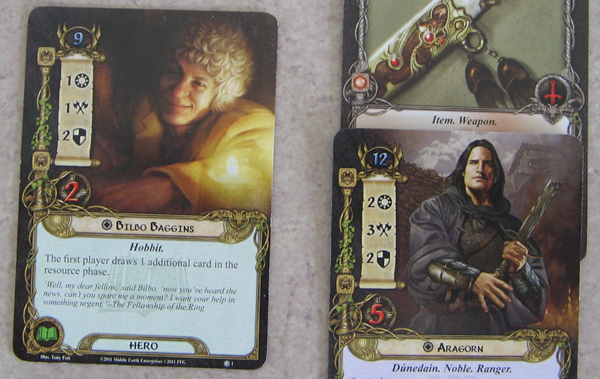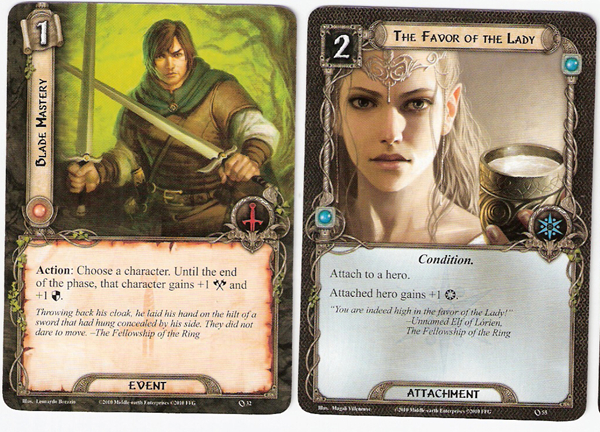Lord of the Rings: The Card Game & Hunt for Gollum Expansion – Card Game Review
 Lord of the Rings: The Card Game. Card Game Review. Publisher: Fantasy Flight Games. Designer: Nate French. $39.95 Base Game, $14.95 Expansion Hunt for Gollum.
Lord of the Rings: The Card Game. Card Game Review. Publisher: Fantasy Flight Games. Designer: Nate French. $39.95 Base Game, $14.95 Expansion Hunt for Gollum.
Passed Inspection: Great looking game with high quality components. Has the Middle Earth ambiance. Fully solitaire compatable! Lovely looking, well written rule book. Has an index! Tons of official and unofficial on-line support.
Failed Basic: Some rule confusion. Card effects subject to interpretation.Third scenario in the core game is almost impossible to win.
{default}When J.R.R. Tolkien wrote the cornerstones of fantasy fiction The Hobbit and The Lord of the Rings trilogy, he must never have imagined the effect his books would have upon the world. The Lord of the Rings and The Hobbit have helped to define fantasy fiction, games (including Arneson & Gygax’s Dungeons & Dragons), movies and even lifestyles and religion. For many, the world of Tokien epitomizes fantasy as a genre.
Throughout the years, there have been many officially (and not-so-officially) licensed Lord of the Rings games – from role playing games to war games and collectable card games. The wizards at Fantasy Flight Games have come out with a “living card game” set in Middle Earth. A “living card game” is a distinguished from a “collectable card game” or “CCG” in that the cards do not have to be purchased in randomly packaged booster packs but can all be purchased either with the core-rules or in expansions. This makes “living card games” far more economical for the casual player to collect, as opposed to having to hunt down that one precious rare card on Ebay for crazy money ala Magic the Gathering.
The Lord of the Rings: The Card Game’s scenarios are set 17 years after Bilbo Baggin’s 111st birthday party on the day before Frodo leaves the Shire to embark on the quest chronicled by The Lord of the Rings trilogy. The game can be played with 1 or 2 players – or 3 and 4 if you have an extra copy of the core set available. While I have yet to play a 3 or 4 player game, it plays wonderfully as a solitaire game and is very enjoyable with two players cooperating to beat the game’s scenarios. This is not a game for multiplayer maham and backstabbing, but in the grand tradition of Tolkien’s stories, the players must work together or they will all fall to the evil of Sauron.
A look at some of the cards used in the game. Click to enlarge the image.
The cards are broken into Hero cards (Aragorn, Legolas, Bilbo [in the first expansion], etc.); Quest cards, which include items to use with the heroes, special allies to help add to the party of adventurers, spells, etc.; Enemy cards (orcs, wargs, etc.); Location cards (places of danger which the heroes must explore); Treachery cards that affect the party in negative ways; and, last but not least, Objective cards, which must be captured by our heroes and add to the chances of winning the scenario. The basic game, aka the Core Set, includes three different scenarios of varying difficulty. The first and easiest is the Passage Through Mirkwood. Next and more intermediate is Journey Down the Anduin. The last and most difficult is the nearly impossible to win Escape from Dol Guldur. I have played that scenario twice solitaire and one time as a two-player game and have yet to win it. It seems to be almost too difficult to win and I must say that I shall try it one more time and if I can’t beat it, I’ll just give up.
Briefly, the game’s turn sequence is as follows:
- Players add resources to their heroes which will allow them to bring allies in to play, use special attacks and other events and attach items to the characters.
- The characters modify their party with allies, items, and such which they purchase using their resources.
- The players commit heroes and allies to the Quest card that is currently in play. Each scenario can have three or more numbered, double-sided cards that represents the different locations in a particular quest. Then the players find out what threats are at that location or quest and find out if they can explore the locations.
- Players find out what foes attack them and then engage in combat with everything from Orcs to dastardly spells and other treacheries. If the players defeat the monsters and other encounters, they may win possession of an Objective item or maybe even free a prisoner from a dungeon.
- Finally, players “untap” or “refresh” their characters to prepare for the next turn and raise the party’s “Threat Level” by one point.
The “Threat Level” is an important part of The Lord of the Rings: The Card Game. Included in the game are two evil-looking dials bearing the eye of Sauron. These dials represent the threat level of the particular scenario and, in the first three scenarios, if the threat level ever goes beyond 50 points, the player(s) lose.
Some cards allow for the threat level to be lowered, effectively buying the player(s) a little more time to try and complete their scenario. The most effective way of doing this is by bringing the ally card Gandalf the Grey in to play. He doesn’t stay long but he is, rightly enough, extremely powerful. Use Gandalf at the proper time and you may win a losing game.
Each card is loaded with information – heroes are rated for their willpower, attack strength, defense strength, hit points, traits, sphere of influence and how powerful they are. Luckily, the game features a well-illustrated rule book with plenty of charts and examples of play.
During combat, which can be a very nasty affair, you will find your characters being attacked by some of the creatures found in Middle Earth. To add to the surprise, when a creature attacks, it also gets a “Shadow Effect” played during its attack. Shadow Effects are written on the bottom of some cards and can do everything from raising the Threat Level to costing the hero a magic item. Almost as bad are “Treachery Cards” which can affect the entire party. Once, while almost beating the dreaded third scenario in the game, I drew a Treachery Card that raised the threat level above 50 and ended my game in a defeat for my party.
Some of the threats players will face. Click to enlarge the image.
After playing the game several times, the gameplay becomes second nature. There is some confusion in the Core Game due to some unclear rules, including how to quest and exhaust a character. At times the effects of the cards are written too nebulously, causing play to stop as rules lawyers attempt to figure out the card text. This is, unfortunately, all too common in card games of this type.
Also, there is no limit to the number of cards a player can have in his or her hand. This can make for some very difficult juggling of cards just to see what you have. A hand limit may have been a nice addition to avoid this.
All but a few Quest Cards are rated per their “Sphere of Influence” – either Leadership, Lore, Spirit, or Tactics. If you don’t have a hero who can use a given Sphere of Influence you can’t draw cards of that type in to your hand to play. Some cards alleviate this effect, but it would have been nice to have a blanket rule that heroes can use cards outside their Sphere of Influence by paying double the cost.
Already a growing number of fan supported scenarios and FAQs are online. In fact, Fantasy Flight has released a very nice six-page FAQ which helps with some of the rule confusion.
The first Adventure Pack has arrived on the shelves of gaming stores and is entitled The Hunt for Gollum. This $15 expansion adds a whole new scenario which is challenging and fits in nicely with the lore of Gollum. Fantasy Flight says that this is the first of monthly scenario releases for this fine game.
Overall, The Lord of the Rings: The Card Game is a wonderful game and fully captures the feel of Middle Earth! Plus, its solitaire capability is a great bonus!
Armchair General Rating: 90 %
Solitaire Rating: 5
About the Author
A college film instructor and small business owner, Richard Martin has also worked in the legal and real estate professions, is involved in video production, film criticism, sports shooting and is an avid World War I and II gamer who can remember war games which came in plastic bags and cost $2.99 (he’s really that old)!

Bilbo & Aragorn.




Excellent review. Thanks for doing it.
Thank you for your kind comment. I’m glad you liked the review. Let me know what you think of the game and if you can win scenario 3.
Excellent review. Couldn’t agree more–my girlfriend and I love this game and have bought several expansions already. It’s a rare gem of a cooperative game for two. We beat the third scenario about 1/2 the time. Our trouble was the second one. After losing badly 2 or 3 times, we raised our max threat to 60, and that seems to be a fair game.